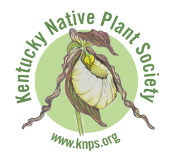By Susan Harkins
We have exciting news — KNPS is partnering with horticultural education groups across the state to provide funds and educational support for pollinator gardens. 2023 is a pilot year so we can find partners throughout the state and work out the kinks.
We’re partnering with organizations with an education mission because the success rate of grant gardens is small. With a two-year educational support commitment from our educational partners, we hope to improve the success rate.
The partnership includes three parties:
- The Kentucky Native Plant Society as grantor will provide funds for the purchase of native plants and seeds.
- The grantee will be the owner or caretaker of the garden. The site should have education as part of its mission and offer public access, within reason.
- An educational partner will provide education and continued support for at least two years.
Currently, each grant is $500. KNPS and educational partners can assist with purchasing plants. The grantee will use their volunteers to prepare, plant, and maintain the garden.
The five pilot sites
Currently, we have five pilot sites in the works. Two are in Frankfort and three are at or near Eastern Kentucky University.
Gerrard County High School
Kelly Watson, Ph.D. and the associate director of Eastern Kentucky University’s Division of Natural Areas supplied the education component for this new pollinator garden on school grounds. The KNPS grant of $500 was used to purchase native plants from Ironweed Native Plant Nursery in Waddy.
On May 17th, Kelly worked with two shifts of students: One was an Agriculture/Horticulture class (taught by Natasha Parsons), and a second group of students is part of GearUp, working with Amy Whitt. Kelly will continue to support these groups in maintaining the garden to secure its success.


Science for Sustainable Living Initiative
Kelly Watson serves as the educational partner for this pollinator garden outside the EKU science building and the plants were purchased from Ironweed Native Plant Nursery. EKU has two gardens here that are used as outdoor classrooms and during the campus pollinator workshops, which occur twice a year.
The gardens were established two years ago through a grant from Novelis, using seeds from Roundstone Native Seed Company. The groups caring for these gardens have battled invasives since then. By adding mature plugs, the group hopes to tilt the tables a bit more in favor of the natives.
In May, a group of group of summer student interns (they get paid!) and Kelly spent six hours weeding preparing the gardens. The gardens were planted on May 31 and June 2.


EKU Scholar House
Kelly Watson is providing the educational partner for this large outdoor classroom space and plants were purchased from Ironweed Native Plant Nursery. This site already has three large, raised beds and they’re currently working to create a larger outdoor classroom space.
On June 1, EKU Scholar House and EKU Sustainability Office hosted a planting event. Volunteers helped plant the classroom space and children visited educational tables with games and activities. One table taught the children how to plant a seed, and the children took their small pots home!


Second Street School
Connie Lemley of Frankfort facilitated the grant for the group. The plants were purchased from Ironweed Native Plant Nursery and the Capital Area Extension Master Gardeners (CAEMG) will provide educational support to ensure the garden’s success.
On Saturday, June 3, Eagle scout candidate Sam Curry and his fellow scouts planted a pollinator garden at Second Street School in Frankfort, Kentucky. The spot is concrete bound by sidewalks and Second Street, so it will receive a lot of traffic.
First, the group removed a large knock-out rose and turf before planting. Sam has a large number of volunteers to help maintain the garden over the summer. From there, the school’s volunteers, under Connie’s direction, will resume care using Sam’s educational and maintenance plan for guidance.



Liberty Hall Historical Site
Anna Campomanes, the garden curator for Liberty Hall in Frankfort, secured a grant to restore an historical garden that is available to the public. CAEMG is the educational partner.
Anna decided to supplement an existing historical garden with native shrubs. CAEMG visited the site and provided a list of sun-loving native shrubs that would fit the garden nicely and attract pollinators. Many people don’t think of native shrubs when they think of pollinators, so this is a unique opportunity.
Planting is scheduled for fall. Liberty Hall hopes to host a public workshop for planting shrubs that day. This will give KNPS and CAEMG the opportunity to promote native shrubs as pollinators to the public!
Going forward
It’s an auspicious start, and the commitment and enthusiasm from the grantees are infectious! We plan regular updates throughout the summer, so watch for more information in The Lady Slipper.



















